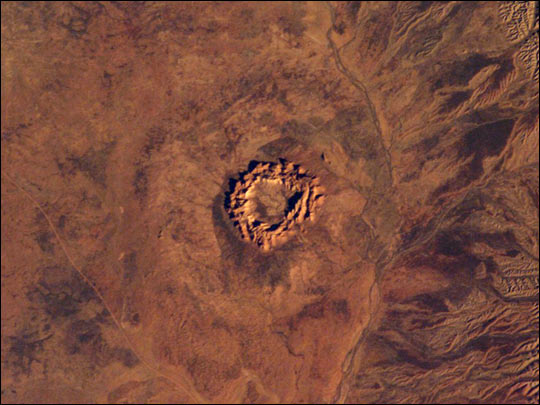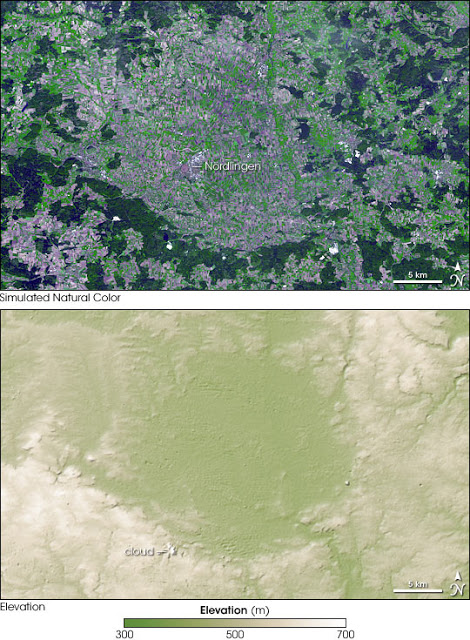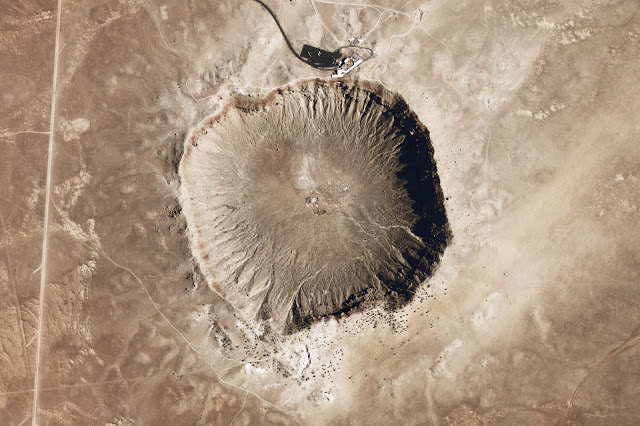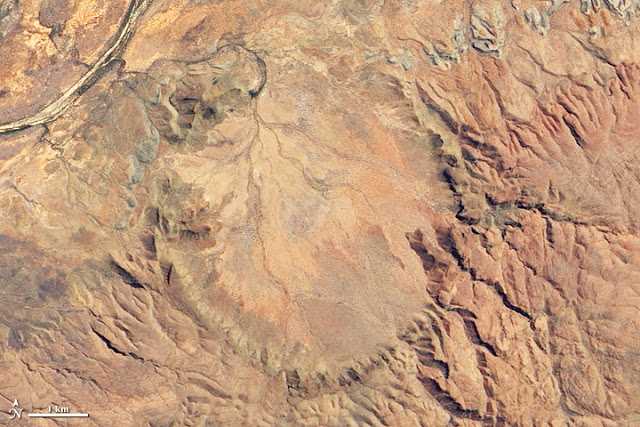| Online: | |
| Visits: | |
| Stories: |

| Story Views | |
| Now: | |
| Last Hour: | |
| Last 24 Hours: | |
| Total: | |
Where Are Earth’s Meteorite Craters? 340 Waiting To Be Discovered
The geologists Prof. Dr. Stefan Hergarten and Prof. Dr. Thomas Kenkmann from the Institute of Earth and Environmental Sciences of the University of Freiburg have published the world’s first study on the question of how many meteorite craters there should be on the Earth’s surface.
Astronaut photograph ISS007-E-05697 was taken with an Electronic Still Camera on May 20, 2003 with a 180-mm lens and is provided by the Earth Sciences and Image Analysis Laboratory at Johnson Space Center
NASA image created by Jesse Allen, using data provided courtesy of NASA/GSFC/METI/ERSDAC/JAROS, and U.S./Japan ASTER Science Team.
Meteorite impacts have shaped the development of the Earth and life repeatedly in the past. The extinction of the dinosaurs, for instance, is thought to have been brought on by a mega-collision at the end of the Cretaceous period. But how many traces of large and small impacts have survived the test of time?
The meteor crater in Arizona, USA, with a diameter of 1.2 kilometers, is the most well-known impact crater. There must still be many undiscovered craters in this size category – but they are older and much less well preserved.
“A surprising, initially sobering finding we made was that there are not many craters of above six kilometers in diameter left to discover on the Earth’s surface,” reports Hergarten. In the case of smaller craters, on the other hand, the scientists found the current list to be far from complete: Around 90 craters with a diameter of one to six kilometers and a further 250 with a diameter of 250 to 1000 meters are still awaiting discovery. While there are undoubtedly still a number undiscovered large craters buried deep under sediments, they are much more difficult to detect and confirm.
Goat Paddock Crater, located on the Kimberley Plateau of northwestern Australia, appears to straddle the simple-complex category, according to a study published in 2005.
Freiburg students have been involved in the research since 2011: The course “Screening Earth – a Student (Re)search Project” is held each year for master’s students in Geology. The course enables aspiring young geologists to participate in the search for undiscovered craters. “The students will have to decide for themselves whether to focus on looking for small craters – or whether it might yet be possible to pull off the coup of discovering one of the last remaining large meteorite craters,” says Kenkmann, who received the Baden-Württemberg State Teaching Award for the course in 2012.
Prof. Dr. Stefan Hergarten
Institute of Earth and Environmental Sciences
University of Freiburg
Prof. Dr. Thomas Kenkmann
Institute of Earth and Environmental Sciences
University of Freiburg
Citation: S. Hergarten & T. Kenkmann (2015) The number of impact craters on Earth: Any room for further discoveries? Earth Planet. Sci. Lett., 425: 187-192. doi 10.1016/j.epsl.2015.06.009
www.sciencedirect.com/science/article/pii/S0012821X15003659
Source:










The Sun Aka Lucifer, Satan and the Devil crater in Arizona, USA, (Canyon Diablo, Arizona)

 Wright brothers – Wikipedia, the free encyclopedia
Wright brothers – Wikipedia, the free encyclopedia 

the sun comes down from heaven and seems to set upon the ground. (Canyon Diablo, Arizona)
must be very much on earth like Arizona, USA, (Canyon Diablo, Arizona)
The Sun crater in Arizona, USA, with a diameter of 1.2 kilometers, is the most well-known impact crater. There must still be many undiscovered craters in this size category but they are older and much less well preserved.
many undiscovered craters
How Many Satellites are in Space? how many satellites are around earth? satellites take close-up pictures of Earth is classified by Microsoft